Submitted:
16 September 2024
Posted:
17 September 2024
You are already at the latest version
Abstract
Keywords:
1. Introduction
2. Materials and Methods
2.1. Study Area
2.2. Data Acquisition and Processing
2.2. Prediction of LULC for 2050
2.3. Accuracy Assessment of LULC Classification
2.4. Post-Classification Change Detection
2.5. Trends of LULC Change Analysis
2.6. Normalized Difference Vegetation Index (NDVI) Estimation
3. Results
3.1. Analysis of LULC Classification
3.1.1. Rate of LULC Classes Changes
| LULC classes | 2005 | 2023 | Change in 2005 and 2023 | Rate of change | ||
| Hectares | Hectares | Hectares | % | Hectares | % | |
| Urban | 404.54 | 446.29 | 41.75 | 1.54 | 2.32 | 0.09 |
| Forest | 1769.63 | 1713.4 | -55.6 | -2.07 | -3.09 | -0.12 |
| Water bodies | 49.71 | 164.79 | 115.08 | 4.25 | 6.39 | 0.24 |
| Agricultural land | 487.38 | 387.08 | -100.3 | -3.7 | -5.57 | -0.21 |
3.1.2. LULC Classes Change Maps and Detection Statistics
3.2. NDVI Estimation for 2005, 2015, and 2023
4. Discussion
5. Conclusions
Author Contributions
Funding
Data Availability Statement
Conflicts of Interest
References
- Polasky, S., Nelson, E., Camm, J., Csuti, B., Fackler, P., Lonsdorf, E., Montgomery, C., White, D., Arthur, J., & Garber-Yonts, B. (2008). Where to put things? Spatial land management to sustain biodiversity and economic returns. Biological conservation, 141(6), 1505-1524. [CrossRef]
- Wang, J., Sui, L., Yang, X., Wang, Z., Ge, D., Kang, J., Yang, F., Liu, Y., & Liu, B. (2019). Economic globalization impacts on the ecological environment of inland developing countries: A case study of Laos from the perspective of the land use/cover change. Sustainability, 11(14), 3940. [CrossRef]
- Kusimi, J. M. (2008). Assessing land use and land cover change in the Wassa West District of Ghana using remote sensing. GeoJournal, 71(4), 249-259. [CrossRef]
- Lambin, E. F., Geist, H. J., & Lepers, E. (2003). Dynamics of land-use and land-cover change in tropical regions. Annual review of environment and resources, 28(1), 205-241. [CrossRef]
- Sarfo, I., Bi, S., Kwang, C., Yeboah, E., Addai, F. K., Nkunzimana, A., Ofori, M. A., Batame, M., Appea, E. A., & Asiedu, A. (2023). Class dynamics and relationship between land-use systems and surface temperature in south-eastern Ghana. Environmental Earth Sciences, 82(4), 104. [CrossRef]
- Dewan, A. M., & Yamaguchi, Y. (2009). Land use and land cover change in Greater Dhaka, Bangladesh: Using remote sensing to promote sustainable urbanization. Applied geography, 29(3), 390-401. [CrossRef]
- Wang, L., & Yang, Z.-L. (2020). Changes in land use influenced by anthropogenic activity. In Oxford Research Encyclopedia of Environmental Science. [CrossRef]
- Malede, D. A., Alamirew, T., Kosgie, J. R., & Andualem, T. G. (2023). Analysis of land use/land cover change trends over Birr River Watershed, Abbay Basin, Ethiopia. Environmental and Sustainability Indicators, 17, 100222. [CrossRef]
- Kanjin, K., & Alam, B. M. (2024). Assessing changes in land cover, NDVI, and LST in the Sundarbans mangrove forest in Bangladesh and India: A GIS and remote sensing approach. Remote Sensing Applications Society and Environment, 36, 101289. [CrossRef]
- Gutierrez Garzon, A. R., Bettinger, P., Siry, J., Mei, B., & Abrams, J. (2020). The terms foresters and planners in the United States use to infer sustainability in forest management plans: A survey analysis. Sustainability, 12(1), 17. [CrossRef]
- Bardsley, D. K., Cedamon, E., Paudel, N., & Nuberg, I. (2024). Forest livelihood values and management opportunities to support the agrarian transition in Nepal. Journal of Rural Studies, 107, 103253. [CrossRef]
- Kumar, M., Phukon, S. N., & Singh, H. (2021). The role of communities in sustainable land and forest management. In Forest resources resilience and conflicts (pp. 305-318). Elsevier. [CrossRef]
- Briassoulis, H. (2009). Factors influencing land-use and land-cover change. Land cover, land use and the global change, encyclopaedia of life support systems (EOLSS), 1, 126-146.
- Corbera, E., Estrada, M., May, P., Navarro, G., & Pacheco, P. (2011). Rights to land, forests and carbon in REDD+: insights from Mexico, Brazil and Costa Rica. Forests, 2(1), 301-342. [CrossRef]
- Haji, L., Valizadeh, N., & Hayati, D. (2020). The role of local communities in sustainable land and forest management. In Spatial Modeling in Forest Resources Management: Rural Livelihood and Sustainable Development (pp. 473-503). Springer. [CrossRef]
- Patel, R., Mukherjee, S., Sahu, B., Dash, B., Jaison, M., Avinash, K., & Singh, P. (2024). Sustainable Forest Management (SFM) for C Footprint and Climate Change Mitigation. In Agroforestry to Combat Global Challenges: Current Prospects and Future Challenges (pp. 203-217). Springer. [CrossRef]
- Hu, Y., Raza, A., Syed, N. R., Acharki, S., Ray, R. L., Hussain, S., Dehghanisanij, H., Zubair, M., & Elbeltagi, A. (2023). Land use/land cover change detection and NDVI estimation in Pakistan’s Southern Punjab Province. Sustainability, 15(4), 3572. [CrossRef]
- Lambin, E. F. (1999). Land-use and land-cover Change (LUCC)-implementation strategy. A core project of the international geosphere-biosphere programme and the international human dimensions programme on global environmental change.
- Turner, B. L., Skole, D., Sanderson, S., Fischer, G., Fresco, L., & Leemans, R. (1995). Land-use and land-cover change: science/research plan. [No source information available].
- Mikeladze, G., Gavashelishvili, A., Akobia, I., & Metreveli, V. (2020). Estimation of forest cover change using Sentinel-2 multi-spectral imagery in Georgia (the Caucasus). iForest-Biogeosciences and Forestry, 13(4), 329. [CrossRef]
- Housman, I. W., Chastain, R. A., & Finco, M. V. (2018). An evaluation of forest health insect and disease survey data and satellite-based remote sensing forest change detection methods: Case studies in the United States. Remote Sensing, 10(8), 1184. [CrossRef]
- Wang, J., Sammis, T. W., Gutschick, V. P., Gebremichael, M., Dennis, S. O., & Harrison, R. E. (2010). Review of satellite remote sensing use in forest health studies. The Open Geography Journal, 3(1). [CrossRef]
- Wu, G., De Leeuw, J., Skidmore, A. K., Prins, H. H., & Liu, Y. (2008). Comparison of MODIS and Landsat TM5 images for mapping tempo–spatial dynamics of Secchi disk depths in Poyang Lake National Nature Reserve, China. International Journal of Remote Sensing, 29(8), 2183-2198. [CrossRef]
- Wulder, M., & Loveland, T. (2019). Roy, DP Crawford, CJ Masek, JG Woodcock, CE Allen, RG Anderson, MC Belward, AS Cohen, WB Dwyer, J. Erb, A. Gao, F. et al. Current status of Landsat program, science, and applications. Remote Sensing of Environment, 225, 127-147.
- Vogelmann, J. E., Khoa, P. V., Lan, D. X., Shermeyer, J., Shi, H., Wimberly, M. C., Duong, H. T., & Huong, L. V. (2017). Assessment of forest degradation in Vietnam using Landsat time series data. Forests, 8(7), 238. [CrossRef]
- Yang, X., & Lo, C. (2002). Using a time series of satellite imagery to detect land use and land cover changes in the Atlanta, Georgia metropolitan area. International Journal of Remote Sensing, 23(9), 1775-1798. [CrossRef]
- Moisen, G. G., McConville, K. S., Schroeder, T. A., Healey, S. P., Finco, M. V., & Frescino, T. S. (2020). Estimating land use and land cover change in North Central Georgia: Can remote sensing observations augment traditional forest inventory data? Forests, 11(8), 856. [CrossRef]
- Forest Service U.S. Department of Agriculture. (2013). By the Numbers. Retrieved 20/03/2024 from https://www.fs.usda.gov/about-agency/newsroom/by-the-numbers.
- Berget, C., & Dwivedi, P. (2024). Do female and male family forest landowners think alike? A qualitative analysis from Georgia, United States. Trees, Forests and People, 100540. [CrossRef]
- Moore, R., Williams, T., Rodriguez, E., & Hepinstall-Cymerman, J. (2013). Using nonmarket valuation to target conservation payments: An example involving Georgia’s private forests. Journal of Forestry, 111(4), 261-270. [CrossRef]
- Georgia Department of Economic Development. (2024). Southeast Georgia - Region 11. Retrieved 21/03/2024 from https://www.georgia.org/regions/southeast-georgia.
- Breiman, L. (2001). Random forests. Machine learning, 45, 5-32. [CrossRef]
- Kamaraj, M., & Rangarajan, S. (2022). Predicting the future land use and land cover changes for Bhavani basin, Tamil Nadu, India, using QGIS MOLUSCE plugin. Environmental Science and Pollution Research, 29(57), 86337-86348. [CrossRef]
- Muhammad, R., Zhang, W., Abbas, Z., Guo, F., & Gwiazdzinski, L. (2022). Spatiotemporal change analysis and prediction of future land use and land cover changes using QGIS MOLUSCE plugin and remote sensing big data: a case study of Linyi, China. Land, 11(3), 419. [CrossRef]
- Ismail, M. H., & Jusoff, K. (2008). Satellite data classification accuracy assessment based from reference dataset. International Journal of Geological and Environmental Engineering, 2(3), 23-29.
- Meneses-Tovar, C. (2011). NDVI as indicator of degradation. Unasylva, 62(238), 39-46.
- Morshed, S. R. M. R., Fattah, M. A., Rimi, A. A., & Haque, M. N. (2020). Surface temperature dynamics in response to land cover transformation. Journal of Civil Engineering, Science and Technology, 11(2), 94-110.
- Ajagun, E. O., Ashiagbor, G., Asante, W. A., Gyampoh, B. A., Obirikorang, K. A., & Acheampong, E. (2021). Cocoa eats the food: expansion of cocoa into food croplands in the Juabeso District, Ghana. Food Security, 1-20. [CrossRef]
- Amini, S., Saber, M., Rabiei-Dastjerdi, H., & Homayouni, S. (2022). Urban land use and land cover change analysis using random forest classification of landsat time series. Remote Sensing, 14(11), 2654. [CrossRef]
- Junaid, M., Sun, J., Iqbal, A., Sohail, M., Zafar, S., & Khan, A. (2023). Mapping lulc dynamics and its potential implication on forest cover in malam jabba region with landsat time series imagery and random forest classification. Sustainability, 15(3), 1858. [CrossRef]
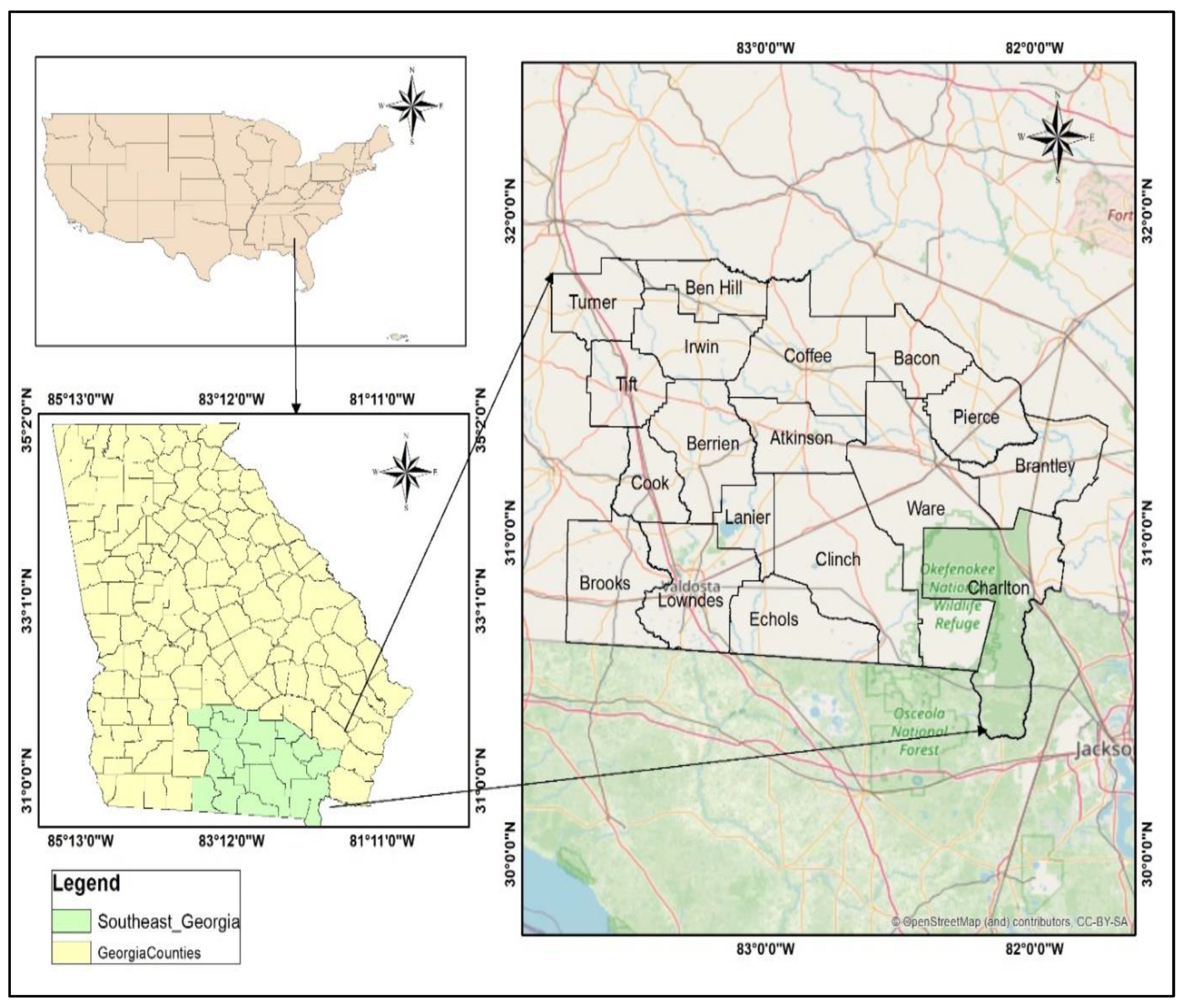
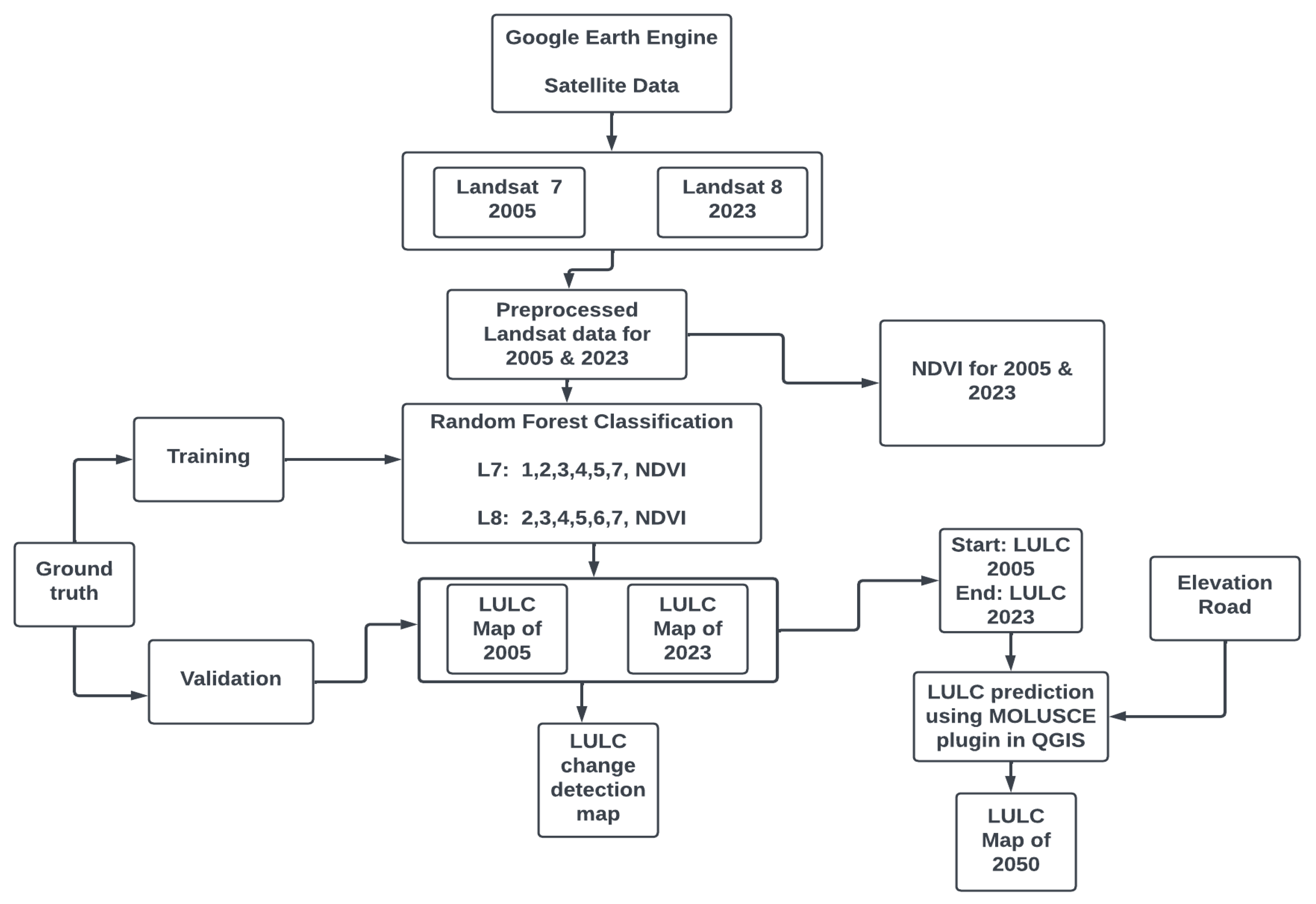
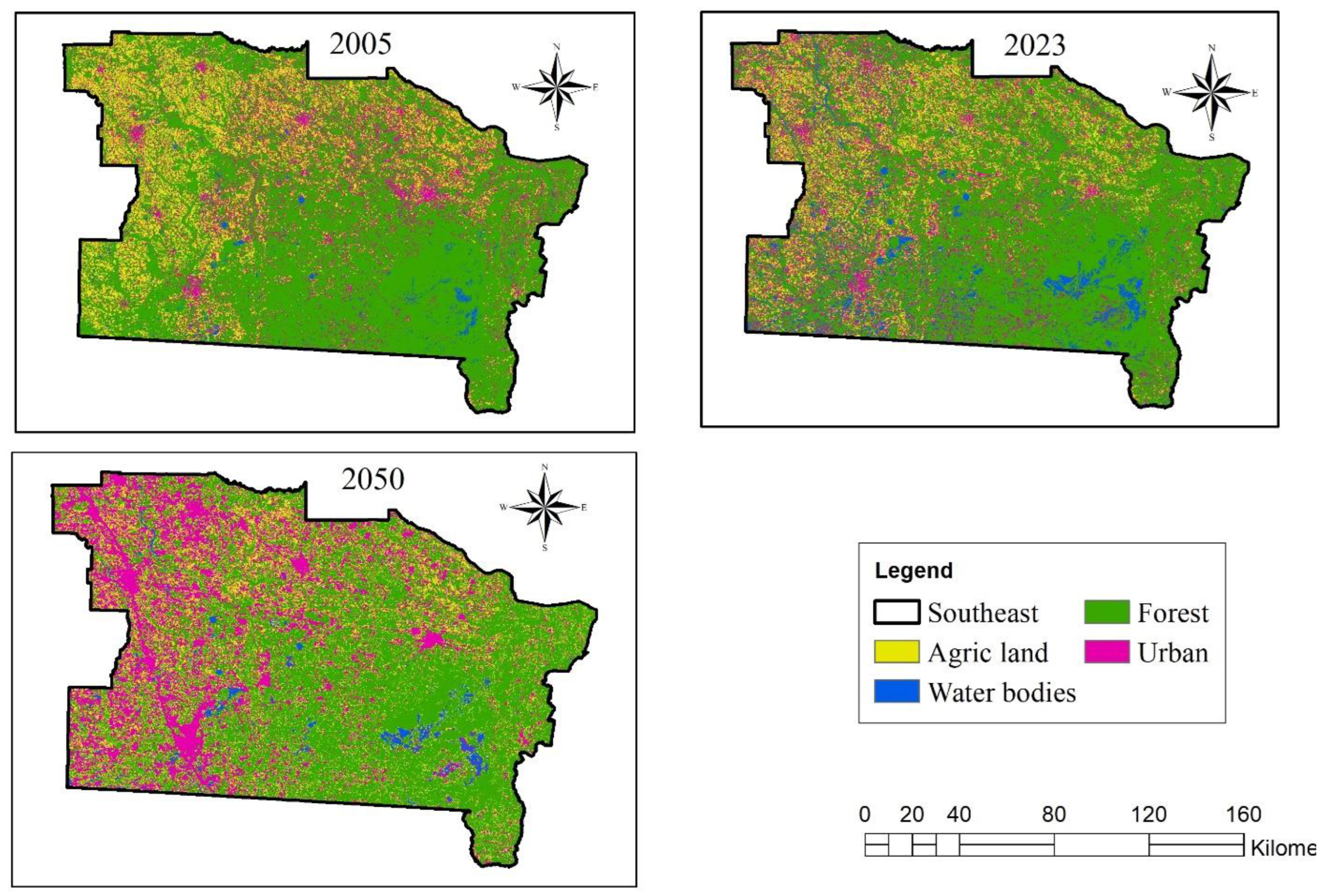
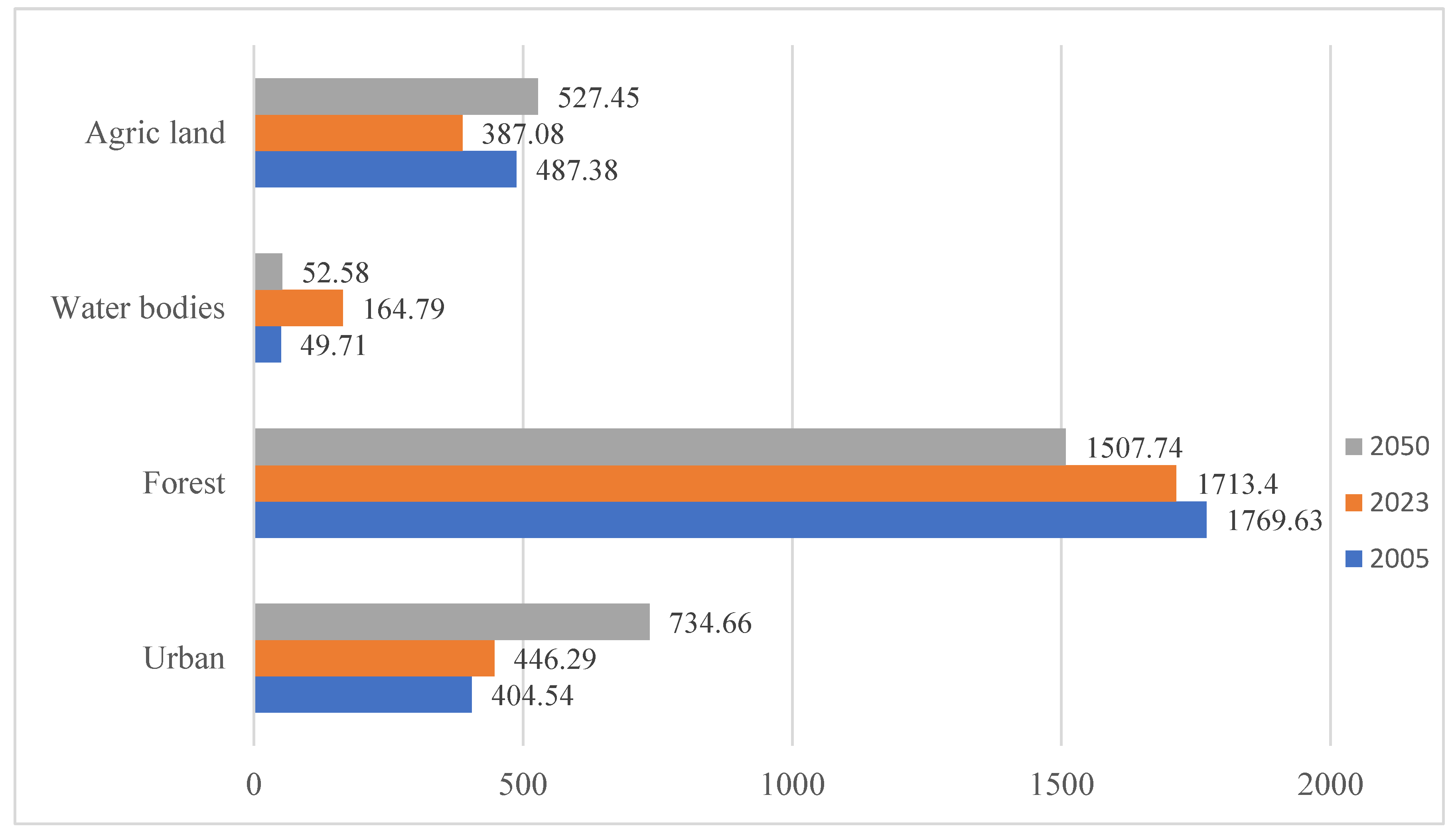
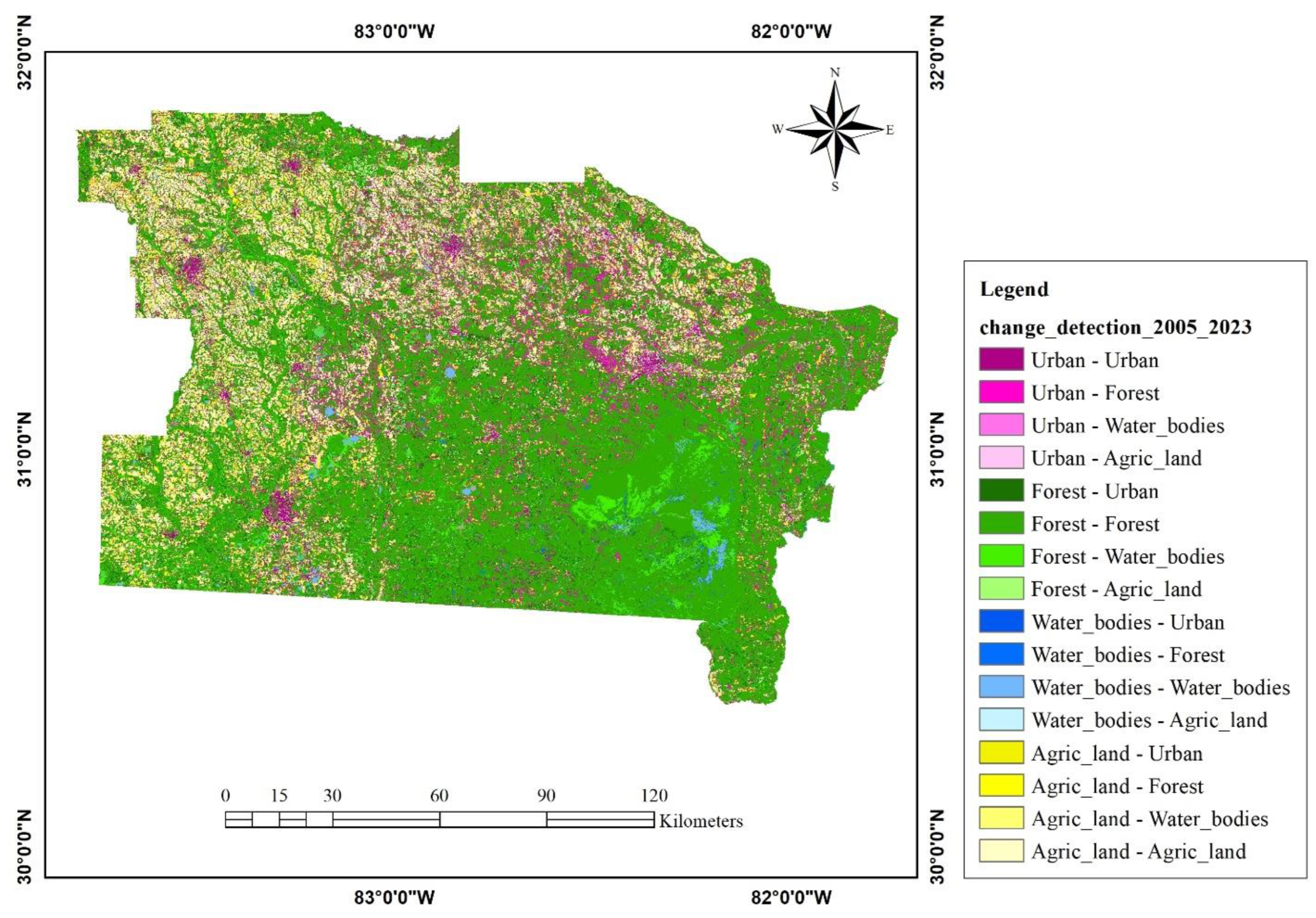
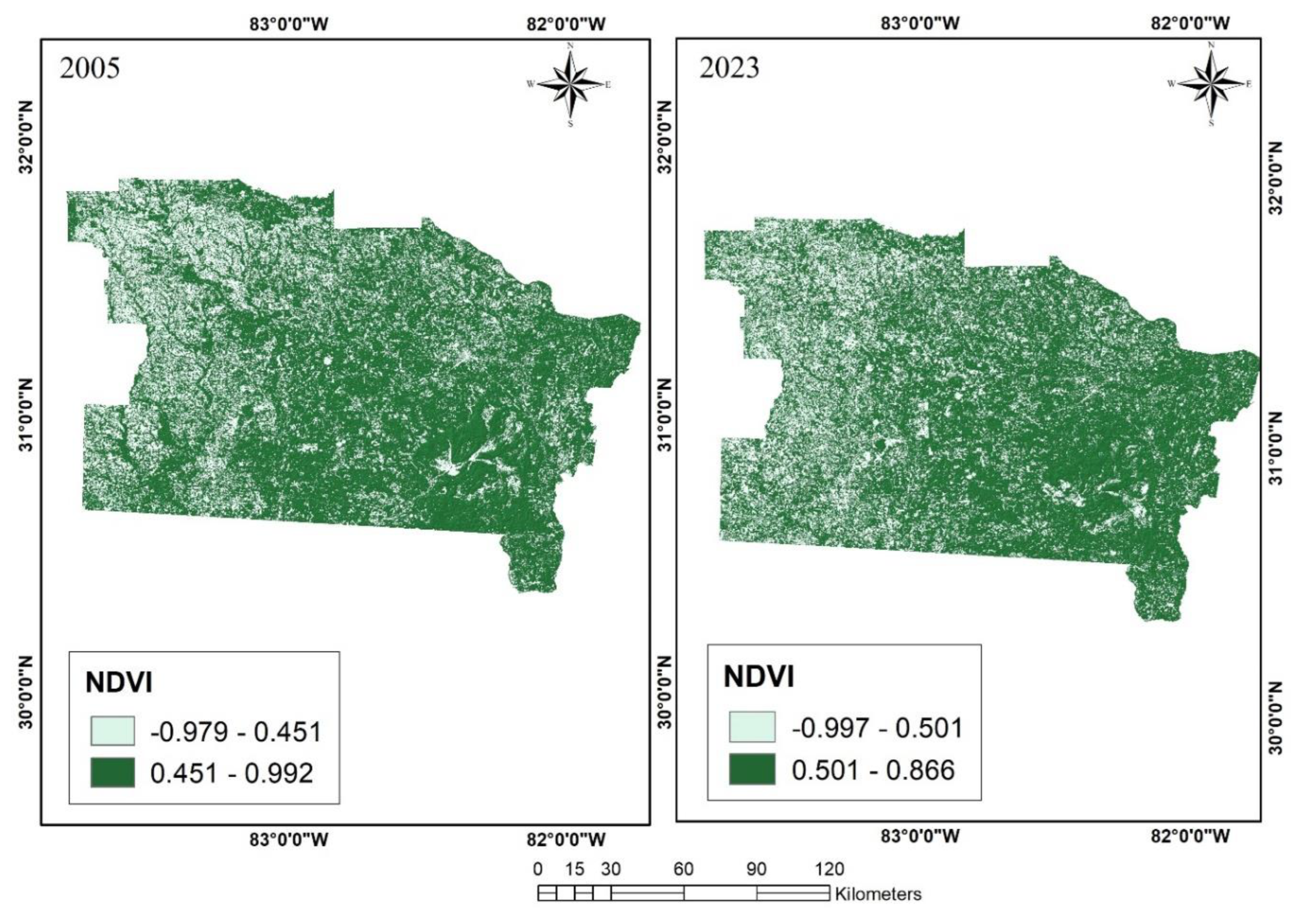
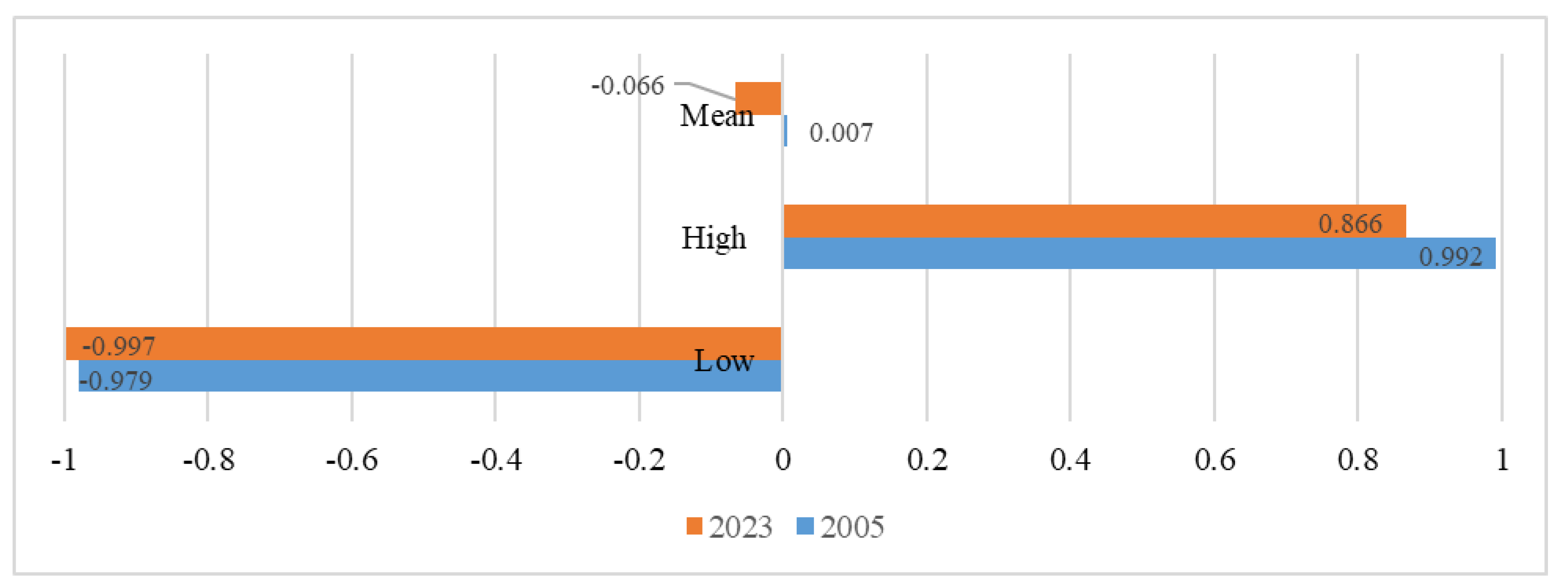
| LULC Class | Description |
|---|---|
| Urban: | Human-induced features: included settlement, roads, areas under construction, bare land, pathways, etc. |
| Forest: | All forms of vegetation, particularly, trees, plantations, etc. |
| Water bodies: | Rivers, ponds, streams, etc. |
| Agricultural land: | Included all lands reserved for farming, such as harvested lands, land under cultivation, etc. |
| LULC Classes | 2005 | 2023 | ||
|---|---|---|---|---|
| Producer Accuracy | User Accuracy | Producer Accuracy | User Accuracy | |
| Urban | 0.70 | 0.69 | 0.74 | 0.71 |
| Forest | 0.88 | 0.97 | 0.94 | 0.92 |
| Water bodies | 0.89 | 0.88 | 0.91 | 0.94 |
| Agricultural land | 0.87 | 0.76 | 0.79 | 0.81 |
| Overall Accuracy | 0.83 | 0.85 | ||
| Kappa | 0.75 | 0.80 | ||
| LULC classes | Percentage changes in acreages | ||||
|---|---|---|---|---|---|
| 2005 | 2023 | 2050 | 2023 – 2005 | 2050 -2023 | |
| Urban | 14.92 | 16.46 | 26.03 | 1.54 | 9.57 |
| Forest | 65.27 | 63.20 | 53.42 | -2.07 | -9.78 |
| Water bodies | 1.83 | 6.08 | 1.86 | 4.25 | -4.22 |
| Agricultural land | 17.98 | 14.28 | 18.69 | -3.7 | 4.41 |
| LULC classes | 2023 | 2050 | Change in 2023 and 2050 | Rate of change | ||
|---|---|---|---|---|---|---|
| Hectares | Hectares | Hectares | % | Hectares | % | |
| Urban | 446.29 | 734.66 | 288.37 | 9.57 | 10.68 | 0.35 |
| Forest | 1713.4 | 1507.74 | -205.66 | -9.78 | -7.62 | -0.36 |
| Water bodies | 164.79 | 52.58 | -112.21 | -4.22% | -4.16 | -0.16 |
| Agricultural land | 387.08 | 527.45 | 140.37 | 4.41% | 5.20 | 0.16 |
| Change (2023-2005) | Area in Hectares |
|---|---|
| Urban - Urban | 126.11 |
| Urban - Forest | 206.55 |
| Urban - Water bodies | 15.71 |
| Urban - Agricultural land | 55.90 |
| Forest - Urban | 187.33 |
| Forest - Forest | 1417.24 |
| Forest – Water bodies | 111.40 |
| Forest – Agricultural land | 52.66 |
| Water bodies - Urban | 1.96 |
| Water bodies - Forest | 11.41 |
| Water bodies – Water bodies | 35.92 |
| Water bodies – Agricultural land | 0.17 |
| Agricultural land - Urban | 130.58 |
| Agricultural land - Forest | 77.12 |
| Agricultural land – Water bodies | 1.35 |
| Agricultural land - Agricultural land | 278.19 |
Disclaimer/Publisher’s Note: The statements, opinions and data contained in all publications are solely those of the individual author(s) and contributor(s) and not of MDPI and/or the editor(s). MDPI and/or the editor(s) disclaim responsibility for any injury to people or property resulting from any ideas, methods, instructions or products referred to in the content. |
© 2024 by the authors. Licensee MDPI, Basel, Switzerland. This article is an open access article distributed under the terms and conditions of the Creative Commons Attribution (CC BY) license (http://creativecommons.org/licenses/by/4.0/).





